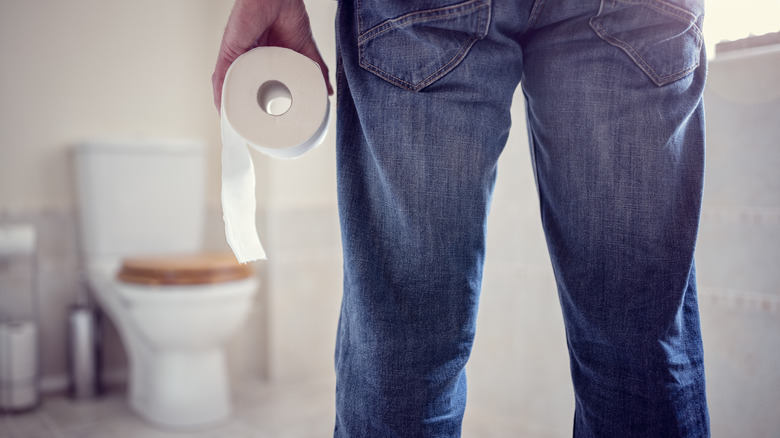What It Means When A Man Has A Slow Pee Stream
During urination, there's a certain degree of force exerted behind our pee stream. We don't need science to tell us that, as we can feel it for ourselves each time we go number one.
Along with the size of our pee stream, force is one of two components that make up what's known as "urinary flow," according to the textbook "Clinical Methods: The History, Physical, and Laboratory Examinations, 3rd Edition" (via National Library of Medicine). In healthy individuals, our pee stream should flow steadily and seamlessly throughout approximately 80% of the urination process. If you experience interruptions, however, and your urine stream has slowed or becomes a little more stop-and-go, this is known as "urinary hesitancy" (per UroCenter). Urinary hesitancy may eventually progress into urinary retention, in which a person struggles to pee altogether. Most often affecting older men, a slow urine stream may be caused by a number of different health conditions, yet it's often traced to one condition in particular.
Enlarged prostate is the usual cause of a slow pee stream
If you've developed a slower-than-normal urine stream, it's likely indicative of benign prostatic hyperplasia (BPH), or an enlarged prostate (via UroCenter). Prevalence rates for BPH stand at around 8% for men in their 40s, but climb to approximately 80% for men in their 90s, according to 2017 research published in the Asian Journal of Urology. For those diagnosed with an enlarged prostate, pressure is exerted from the gland onto the urethra, or the tube that facilitates the movement and discharge of urine from the body. With less room to flow, our urine stream loses force and becomes weaker.
In some cases, urinary hesitancy may be a symptom of bladder or prostate cancer. The U.S. Centers for Disease Control and Prevention (CDC) reports that roughly 13 in every 100 men in the U.S. will be affected by prostate cancer in their life. Along with a weak pee stream, additional symptoms may include difficulty initiating urination, frequent nighttime bathroom trips, burning sensations while peeing, pain during ejaculation, or blood in one's pee or semen. While there is no standard screening test for prostate cancer, healthcare providers may use a prostate-specific antigen (PSA) blood test or a digital rectal examination (DRE), although the latter is not advised by the U.S. Preventive Services Task Force.
Other health conditions that may cause a slow urine stream
A slow urine stream is not always a sign of cancer, however, and may alternatively signal the presence of kidney stones (which men tend to be more prone to), bladder muscle dysfunction, nerve damage, a sexually transmitted infection (STI), or shy bladder syndrome, according to experts at the Urology Center of Florida. A weak pee stream can also be a side effect of certain drugs. It's important to note that urinary hesitancy related to these issues is not solely unique to men. While it may seem like nothing more than a nuisance at first, you don't want to ignore reduced urinary flow or any other unusual symptoms, particularly vomiting, shakes, fever, chills, or back pain. If your pee stream halts completely, go to the nearest emergency room.
Your doctor can help determine what may be the cause of your slower-than-usual pee stream. In addition to taking any prescription medications, some at-home methods for relieving symptoms of urinary hesitancy include soaking in a warm bath, massaging the lower abdomen, applying a warm compress to the area, and keeping up your fluid intake.



